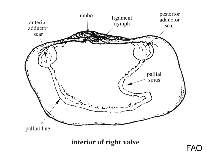Panopea globosa Dall, 1898
Mexican geoduckGoogle image | No image available for this species;
drawing shows typical species in Hiatellidae.
Classification / Names Common names | Synonyms | CoL | ITIS | WoRMS
Bivalvia | Adapedonta | Hiatellidae
Environment: milieu / climate zone / depth range / distribution range Ecology
Benthic. Tropical; 22°N - 25°N (Ref. 100887)
Distribution Countries | FAO areas | Ecosystems | Occurrences | Introductions
Eastern Central Atlantic: Gulf of California.
Length at first maturity / Size / Weight / Age
Maturity: Lm ? range ? - ? cm Max length : 19.8 cm SHL male/unsexed; (Ref. 100951); common length : 11.0 cm SHL male/unsexed; (Ref. 100951)
Life cycle and mating behavior Maturity | Reproduction | Spawning | Eggs | Fecundity | Larvae
Main reference
References | Coordinator | Collaborators
Sabelli, B. and H.S. Feinberg (eds.) 1879 Simon and Schuster's Guide to Shells. Simon and Schuster's Inc. New York. 512 pp. (Ref. 360)
IUCN Red List Status
(Ref. 130435: Version 2025-1)
CITES status (Ref. 108899)
CMS (Ref. 116361)
Threat to humans
Human uses
Fisheries: commercial
| FishSource |
Tools
More information
Diet composition
Food consumption
Predators
Max. ages / sizes
Length-weight rel.
Length-length rel.
Length-frequencies
Mass conversion
Abundance
Internet sources
BHL | BOLD Systems | CISTI | DiscoverLife | FAO(Publication : search) | Fishipedia | GenBank (genome, nucleotide) | GloBI | Gomexsi | Google Books | Google Scholar | Google | PubMed | Tree of Life | Wikipedia (Go, Search) | Zoological Record



